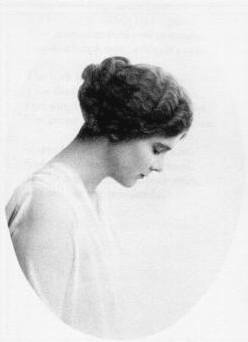Elinor Wylie
| Naissance | |
|---|---|
| Décès | |
| Sépulture |
Forty Fort Cemetery (d) |
| Nom de naissance |
Elinor Hoyt Martyn |
| Nationalité | |
| Activités | |
| Père |
Henry M. Hoyt (en) |
| Conjoint |
William Rose Benét (de à ) |
| A travaillé pour |
|---|
Elinor Morton Wylie (née Elinor Morton Hoyt le et morte le ) est une poétesse et écrivaine américaine ayant connu le succès au cours des années 1920 et 1930.
Biographie
[modifier | modifier le code]Elinor Wylie[1] naît à Somerville (New Jersey)[2],[3], dans une famille établie. Son grand-père, Henry M. Hoyt[4], est gouverneur de Pennsylvanie. Sa tante, Helen Hoyt, est poétesse[5]. Ses parents sont Henry Martyn Hoyt Jr., avocat général des États-Unis[6] de 1903 à 1909, et Anne Morton McMichael. Ses frères et sœurs sont[réf. nécessaire] :
- Henry Martyn Hoyt ( - à New York), qui a épousé Alice Gordon Parker (1885–1951)
- Constance A. Hoyt ( – 1923 en Bavière, Allemagne), qui a épousé Ferdinand von Stumm-Halberg le à Washington (district de Columbia)
- Morton McMichael Hoyt ( à Washington - à Philadelphie).
- Nancy McMichael Hoyt ( à Washington - 1949), romancière.
Elinor grandit à Washington[7]. Elle fréquente la Miss Baldwin's School (1893–97), la Mrs. Flint's School (1897–1901) et la Holton-Arms School (1901–04)[8].

Son premier mari est Philip Simmons Hichborn[9] (1882–1912). Ils se marient le . Le couple a un fils, Philip Simmons Hichborn, Jr., né le à Washington.
À la fin de 1910, Wylie quitte son époux et son enfant pour épouser Horace Wylie.
Encouragée par Horace Wylie, Elinor publie anonymement Incidental Number (1912), un recueil de poèmes écrits la décennie précédente[9].
Souffrant d'hypertension artérielle, elle meurt le à Manhattan, elle est inhumée au cimetière de Forty Fort dans le comté de Luzerne en Pennsylvanie[4].
Œuvres
[modifier | modifier le code]Poésie
[modifier | modifier le code]- (en) [Anonyme], Incidental Numbers. London: private, 1912.
- (en)Nets to Catch the Wind. New York: Harcourt, Brace, 1921.
- (en)Black Armour. New York: Doran, 1923.
- (en)Trivial Breath. New York, London: Knopf, 1928.
- (en)Angels and Earthly Creatures: A Sequence of Sonnets Henley on Thames, UK: Borough Press, 1928. (also known as One Person).
- (en)Angels and Earthly Creatures. New York, London: Alfred A. Knopf, 1929. (includes Angels and Earthly Creatures: A Sequence of Sonnets).
- (en)Birthday Sonnet. New York: Random House, 1929.
- (en)Collected Poems of Elinor Wylie. New York: Alfred A. Knopf, 1932.
- (en)Last Poems of Elinor Wylie, transcribed by Jane D. Wise, foreword by William Rose Benet, tribute by Edith Olivier. New York: Knopf, 1943. Chicago: Academy, 1982.
- (en)Selected Works of Elinor Wylie. Evelyn Helmick Hively ed. Kent State U Press, 2005.
Romans
[modifier | modifier le code]- (en)Jennifer Lorn: A Sedate Extravaganza. New York: Doran, 1923. London: Richards, 1924.
- (en)The Venetian Glass Nephew. New York: Doran, 1925. Chicago: Academy, 1984.
- (en)The Orphan Angel. New York: Knopf, 1926. Also published as Mortal Image. London: Heinemann, 1927.
- (en)Mr. Hodge & Mr. Hazard. New York. Knopf, 1928. London: Heinemann, 1928. Chicago: Academy, 1984.
- (en)Collected Prose of Elinor Wylie. New York: Knopf, 1933.
Archives
[modifier | modifier le code]- (en) Papers reside in the Elinor Wylie Archive, Beinecke Rare Book Room and Manuscript Library, Yale University, New Haven, CT, and in the Berg Collection, New York Public Library[10].
Notes et références
[modifier | modifier le code]- (en) Cet article est partiellement ou en totalité issu de l’article de Wikipédia en anglais intitulé « Elinor Wylie » (voir la liste des auteurs).
- (en) « Elinor Wylie | American writer », sur Encyclopedia Britannica (consulté le )
- (en) Poetry Foundation, « Elinor Wylie », sur Poetry Foundation, (consulté le )
- (en) Elinor Wylie, « Elinor Wylie - Poet | Academy of American Poets », sur Elinor Wylie, (consulté le )
- (en) « Elinor Wylie », sur Find a grave
- (en) Taylor, Georgina, H.D. and the Public Sphere of Modernist Women Writers 1913-1946 : Talking Women, Oxford, Oxford University Press, , 240 p. (ISBN 0-19-818713-0), p. 76
- (en) « Elinor Wylie (Elinor Morton Hoyt Wylie) Biography - (1885–1928) », sur www.jrank.org (consulté le )
- (en) Claribel A. Moroney, An Investigation of the "Fragile Escape in the Work of Elinor Wylie (Masters Thesis), Chicago, Loyola University, (lire en ligne)
- (en)"« Wylie, Elinor (1885 - 1928) », sur Representative Poetry Online, .
- (en)"Elinor Wylie 1885-1928," Poetry Foundation, Web, Apr. 7, 2011.
- "Elinor Wylie: Bibliography," The Poetry Foundation, Web, Aug. 6, 2011.
Bibliographie
[modifier | modifier le code]- (en) Stanley Olson, Elinor Wylie: A Biography, New York, Dial, 1979.
- (en) Evelyn Helmick Hively, « Elinor Wylie », Twentieth Century Criticism, vol. 8, Detroit, Gale Research, 1982.
- (en) Evelyn Helmick Hively, A Private Madness: The Genius of Elinor Wylie, Kent State U P, 2003.
Liens externes
[modifier | modifier le code]
- Ressources relatives à la littérature :
- Ressources relatives à la musique :
- Ressource relative au spectacle :
- Ressource relative à la bande dessinée :
- Notices dans des dictionnaires ou encyclopédies généralistes :
